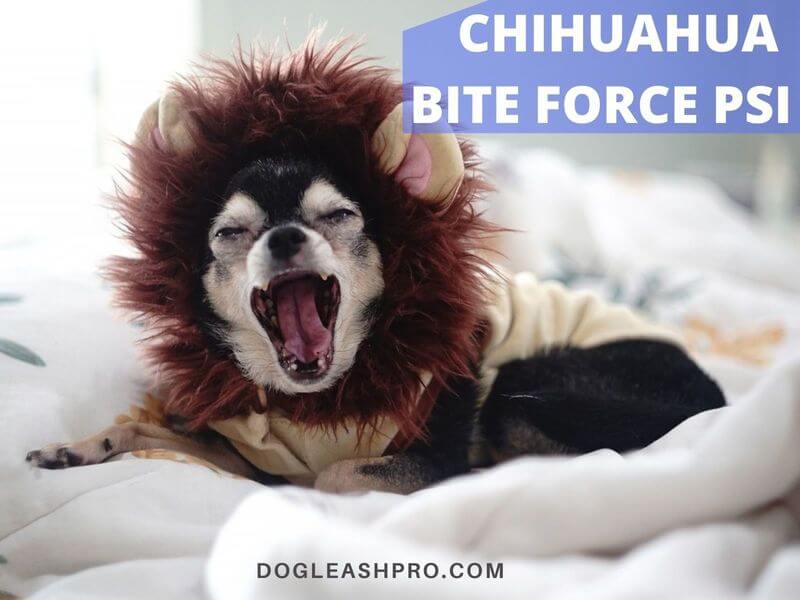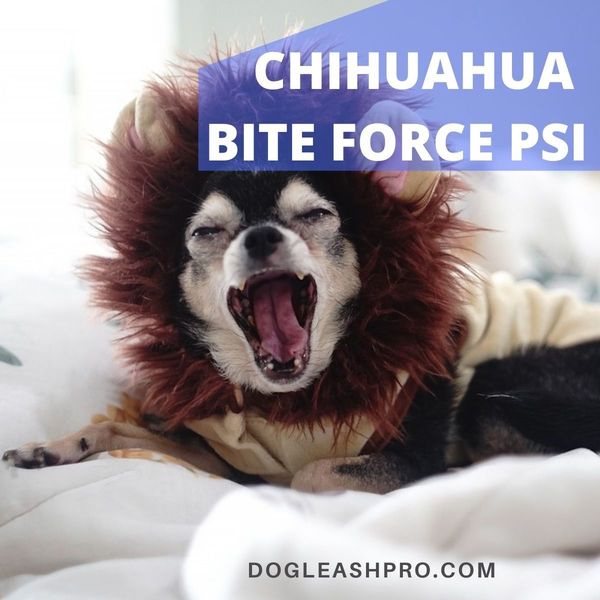
If there’s anything you need to know about Chihuahuas, it’s that this small dog breed is known to be as aggressive and brave as a Terrier. However, they are also sensitive, loyal, devoted, and overly protective of their owners. You’ve probably seen videos of Crying Chihuahua when their owners are not at home.
Although Chihuahuas may be small in size, never underestimate their fearless personalities. I know because I have one. Her name is Lily and she hates new visitors. When my best friend came to visit me last Christmas, Lily started to growl, bark, and bare her teeth. My friend tried to pet Lily and almost got bitten in the hand by my Chihuahua!
This incident had me wondering all sorts of questions. In particular, I was wondering what the bite force of a Chihuahua is and if it’s possible for this tiny dog breed to injure a human. What I discovered from my detailed research was shocking. Scroll towards the bottom to find out the Chihuahua bite statistics and the annual fatalities so you don’t miss it.
Let’s dive right in and find out the bite force of a Chihuahua.
Table of Contents
How strong is a Chihuahua bite force?

To find out the strength or pressure of a Chihuahua bite force, we looked into multiple sources, and here is our best estimate:
The Chihuahua bite force PSI is about 100 PSI or pounds per square inch. PSI is the pound-force per square inch or pressure of one pound of force applied to one square inch of a surface area.
There are articles and research papers that place the bite force or PSI at 3,900. PSI stands for pound-force per square inch.
Isn’t this shocking?! The average bite force of a human being is only 126 pounds per square inch or PSI and the bite force of a tiger is 1,050 PSI, so if a Chihuahua bite force is 3,900 PSI, how is it possible that a tiny dog breed Chihuahua has a bite force that is at more than 3 times the strength of a tiger?
Logically, I don’t believe the 3,900 PSI figure and am not sure how realistic that number is. If that was the case, many Chihuahua owners should secure their premises by putting up fences in their backyard or having a wireless dog fence system so that both strangers and your pup stay safe.
I noticed I am not the only skeptic out there. Many of the researchers and scientists I’ve found also pointed out that there are so many variables involved that the Chihuahua bite force PSI figure is questionable.
One particular researcher is a University of British Columbia professor named Stanley Coren. He wrote in Psychology Today that he doesn’t believe dogs can have a bite force PSI of 2,000 pounds or more. He explained that the pressure of the dog’s bite force reported may be incorrect since it is common for someone to get the Newtons and pounds of forces confused or mix up units of measurement.
Additionally, he pointed to a 2009 research paper done by a group of animal scientists that discussed this topic in detail. This research paper explored the forces of biting and cranial dimension in our domesticated dogs and may be more accurate.
Professor Stanley Coren of psychology states that:
“The size of the animal and the shape of its jaw predicted bite strength. The larger the dog and the dog’s head, and the wider the jaw, the higher the bite force turned out to be. The dog breed with the largest head and widest mouth is the Mastiff, so it is perhaps not surprising that it has been recently measured as having a bite strength of 552 pounds-just shy of the bite force that the lion has. This force exceeds that of all breeds measured to date.”
PsychologyToday
As you can see from the most recent 2009 research paper, a Chihuahua bite force pounds per square inch or PSI of 3,900 is utterly nonsensical.
Although Chihuahuas have a fierce personality, they are a tiny dog breed with small jaws and heads. Their aggressiveness compensates for their tiny size as a means of survival. So don’t let what you see in the media deter you away from thinking about getting a Chihuahua.
In addition to Professor Stanley Coren’s online article, we found other research papers written by researchers Jennifer Lynn Ellis and DL Lindner. They measured the bite force in dogs and published their final results using Newtons as the measurement.
The highest numbers they published on their research paper came out to be 2,000 Newtons. Many of the websites used this number and incorrectly reported it as pounds per square inch or PSI instead of Newtons. For instance, instead of 2,000 Newtons, it was actually 450 pounds per square inch or PSI.
This is why it’s important to consult with numerous sources and not just the first one you see.
Chihuahua bite pressure: what is it really?

While Chihuahuas may be small or toy-sized, they make it clear to everyone around them that they should not be messed with. For the most part, people have gotten the message and luckily no one in my immediate family or friends have been bitten by my Chihuahua.
The truth is that no one has accurately measured how strong the bite force of a Chihuahua is. We scoured the web and read through hundreds of research papers, but could not find a specific scientific research paper on how hard Chihuahuas can bite and what the Chihuahua bite force really is.
It’s also difficult to measure the pressure of a dog’s bite force because dogs will naturally be gentle on objects you give them unless it’s a toy or food.
Performing research studies to measure their bite force PSI can also be tricky. Dogs may not understand that you need them to bite down on something as hard as they can.
This is why the numbers we find online for a Chihuahua bite force pressure in pounds per square inch or PSI are unreliable.
Top 20 Dog bite forces from lowest to highest
Let’s compare the Chihuahua bite force PSI with other dog breeds and see how the 3,900 PSI number we found above for Chihuahua is absurd.
| Dog Breeds | Bite Force Pressure in PSI (pounds per square inch) |
| Malinois | 195 |
| English Bulldog | 210 |
| Chow Chow | 220 |
| Dutch Shepherd | 224 |
| Alono Espanol | 227 |
| Doberman | 229 |
| Boxer | 230 |
| Pit Bull | 235 |
| German Shepherd | 238 |
| American Bulldog | 305 |
| Rottweiler | 328 |
| Leonberger | 399 |
| Dogo Argentino | 500 |
| Dogo Canario | 540 |
| English Mastiff | 552 |
| Tosa Inu | 556 |
| Dogue De Bordeaux | 556 |
| Cane Corso | 700 |
| Bandog Dog | 730 |
| Kangal Dog | 743 |
If a Pitbull has 235 PSI and a German Shepherd has a bite force PSI of 238, then it doesn’t make sense that a Chihuahua’s bite force is stronger than these powerful and big beast dog breeds.
Based on this list, we estimate that a Chihuahua bite force is around 100 pounds per square inch, PSI when compared to other large breeds shown here.
Chihuahua bite statistics

With that finding, I wanted to see the actual statistics on Chihuahua bites and found a study conducted in 2009 by the Colorado Veterinary Medical Association and the Coalition for Living Safely with Dogs.
They performed a survey on 188 dog breeds of different size and strength and compared the Chihuahua dog bite statistics with those of other dog breeds.
They found these two captivating information from their research:
- Compared with other dog breeds, Chihuahuas are most likely to bite veterinarians during vet visits.
- Chihuahuas must hate children because they rank number 4 in dog breeds that have bitten children. This is why we highly recommend that you keep your Chihuahuas away from your babies, toddlers, and little children to prevent any biting accidents.
Very recently in 2016, the Dognition company also canvassed 4,000 dog owners to get their opinions on the most aggressive dog breeds. The result was unsurprising as most dog owners said the Chihuahuas were the most aggressive dog breed when compared with other dog breeds.
Dog owners were asked to note down how their dogs reacted in any given situation. The survey also found this piece of information that I thought made perfect sense:
When confronted by a larger dog, there is a very high chance that a Chihuahua would react by biting in order to defend and protect itself. It’s not surprising to learn this because that’s how survival instincts work.
The report did point out that most of the dog breeds in this study were not known to be the aggressive type when compared to Chihuahua and in most cases, the Chihuahua actually scored around the middle range.
Chihuahua bite fatalities
Ofcourse, if you mess with Chihuahuas, they will react by snapping or biting you. It’s their survival instinct afterall. Although the Chihuahua bite force is less than that of a Mastiff or Doberman, don’t let their small heads and jaws fool you.
Since they have small jaws and mouths, they won’t be able to clamp down on your calf, but they will be able to sink their tiny sharp teeth into the skin of your ankles, toes, feet, hands, or fingers and cause bleeding.
So don’t get them angry because they are small and fast so they will be able to dart in and out quickly and will use their sharp teeth to dig into your skin if they have to. Again, never underestimate the power of a Chihuahua.
Speaking of biting incidents, I found something that had me all shook up! Let’s find out what I found.
Chihuahua bites that have injured humans
Every year in the United States, there are reported human fatalities resulting from dog attacks and dog bites. DogsBites.org is a national group for dog bite victims. Their mission is to reduce dog attacks on humans and pets. The website provides annual reports of dog bite fatality statistics in the U.S.
Here is what I found over a 15 year period:
Top 7 Dog breeds most responsible for human fatalities, 2005 to 2019
| Dog Breeds | Fatalities | Percentage of Total |
| American bulldog | 16 | 3.1% |
| German shepherd | 22 | 4.2% |
| Husky | 14 | 2.7% |
| Mastiff/Bullmastiff | 18 | 3.5% |
| Mixed-breed | 27 | 5.2% |
| Pit bull | 346 | 66.4% |
| Rottweiler | 51 | 9.8% |
From 2005 to 2017, a 13 year period, there was one human fatality logged as a result of the bite force of Chihuahua here in the United States.

Between 2005 to 2017, Chihuahua was responsible for one human fatality.
In 2018, there was another recorded fatality with a Chihuahua involved, which makes two human fatalities from 2005 to 2020.
When I looked into this further, I found out that it’s hard to determine whether this human fatality was due to a Chihuahua attack because this person also had two Pit Bulls, a dog breed that is known to cause the most human fatalities from our chart above.
For this reason, we don’t know if the fatality was caused by a Chihuahua since there was also no witness to this attack.
If you have a tiny cute Chihuahua, this statistic is hard to believe, right? How can their tiny round head and small jaw be strong enough to hurt a human being?
Since I have a Chihuahua, it’s very hard to imagine, but I can see that happening. Truth be told, her growls and bark do scare me sometimes. I remember trying to feed her chicken meat and placed the food in a separate plate that was not her dog bowl.
She sniffed at the food but didn’t eat it when I was there. So I walked away and did the dishes. Ten minutes later, the plate of chicken meat on the floor looked untouched so I thought it was best to relocate the meat to her dog bowl.
She was upset with me! She charged at me with all her force and snapped at my toes.
I decided to look up similar cases and came across a recent article in the New York Post where a UK woman sustained blood and bruises from a 13-inch tall Chihuahua named Buddy.
The website reported that:
“‘The dog came booming out and kept biting round my legs. The dog was chasing me, nipping my legs and it drew blood,’ said Elliff. ‘I could not move quickly enough. It was chasing round and round me in circles. The 13-inch-tall pooch was getting more and more irate, I was absolutely petrified,’ she continued. ‘It took a wad out of my leg which left me bleeding and with a massive bruise. I was shaking. The way it came at me was full-on aggression. You don’t expect that from such a small dog,’ she said.”
New York Post
Chihuahua bite or Pitbull bite: Which is worse?
As you can see from our findings above, a Chihuahua bite is definitely not worse than a Pitbull bite. Many sites and research papers have listed Pitbulls as causing the most fatalities due to their bite force.
Pitbulls always get a bad reputation, but we are here to say that they are one of the most loving and loyal dog breeds.
To answer this question based on statistics, we know that there were these many fatalities between 2005 and 2019 from Chihuahua and Pit bulls:
- Fatalities from Chihuahua bite: 1
- Fatalities from Pitbull bite: 346
This tells us two things: Chihuahua bite force is lower than Pitbull bite force and Chihuahua bites aren’t as fatal or dangerous as Pitbull bites.
RECOMMENDED: Pitbull Chihuahua Mix (Chipit Complete Guide)
Lasting Thoughts
As you can see from the information above, while Chihuahuas do exhibit aggressive behaviors like snapping, biting, or barking, there’s no need to be afraid of them. They will bite out of survival instinct, but it’s not likely that their nasty bite will cause you your life.
Their bites are not hard, but it will hurt since they do have small teeth and can nip at your skin causing a bit of blood.
Chihuahuas are small so it’s not an apple to apple comparison when you’re comparing them to the bite force of a Pitbull or the bite force of a German Shepherd. Their bite force pressure will definitely be lower due to the size of their head and jaws.
Related Questions
Based on our Top 20 dog bite force chart, the Kangal dog has the strongest bite force pressure of 743 PSI or pounds per square inch.
The Chihuahua bite force pressure in PSI is less than 195 or about 100 PSI, thus Chihuahuas won’t be able to bite off a finger.
There may be cases where a Chihuahua may bite into a major vein in one of your fingers and the only way to save your hand is to remove that specific affected finger.
Chihuahuas will generally nibble at your heels and cause some bleeding. There hasn’t been a case where a Chihuahua bit off a finger.

With over five years of specialized experience as an animal writer, my expertise lies in dog nutrition, health, behavior, grooming, and training. I am dedicated to delivering helpful and informative content that caters to the well-being of our furry friends. My primary goal is to empower pet owners with knowledge and ensure our canine companions thrive in health and happiness. In my free time, I love volunteering at local dog rescue centers.






